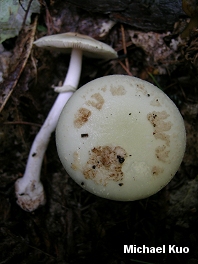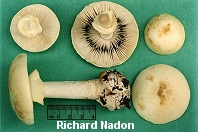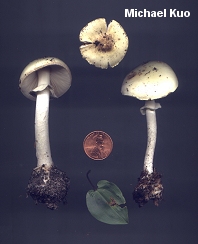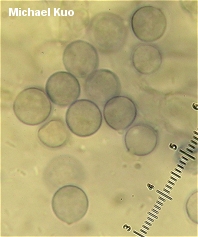| Major Groups > Gilled Mushrooms > Pale-Spored > Amanita > Amanita citrina f. lavendula |

|
Amanita citrina f. lavendula [ Basidiomycetes > Agaricales > Amanitaceae > Amanita . . . ] by Michael Kuo This subtly beautiful Amanita features pale yellow colors, a rimmed basal bulb, and a faintly potato-like odor. It is distributed east of the Rocky Mountains, and is mycorrhizal with hardwoods or conifers. The cap fades quickly, and is often nearly white by old age; it usually features scattered grayish to lavender patches or warts (at least when young). In some collections, lavender to purple stains develop on the cap and stem. There is a nomenclatural nightmare surrounding this mushroom, which North American authors have long treated as "Amanita citrina," assuming it is the same as the European species that often bears the same name. However, for taxonomic reasons the correct name for the European species is actually Amanita bulbosa var. citrina--and that mushroom is, it turns out, distinct from the North American mushroom, leaving the taxonomically awkward Amanita citrina f. lavendula as the best North American name. To complicate matters, Amanita expert Rod Tulloss (2013) reports preliminary DNA results supporting the idea that the North American version of "Amanita citrina" is actually composed of at least three genetically distinct species, and suggests that we can expect "nomenclatural and taxonomic changes" in the near future. Description: Ecology: Mycorrhizal with hardwoods or conifers; growing alone, scattered, or gregariously; summer and fall; widely distributed east of the Rocky Mountains. Cap: 2.5-8 cm, convex to broadly convex or nearly flat in age; sticky when fresh; adorned with soft, grayish to whitish, brownish, or purplish patches or warts when young (but these sometimes disappear by maturity); bald; pale greenish yellow, fading quickly to nearly white; sometimes staining purplish to brownish; margin not lined when young, but sometimes becoming very slightly lined at maturity. Gills: Free from the stem; close or crowded; short-gills frequent; creamy or sometimes yellowish in age. Stem: 4-9 cm long; 0.5-1 cm. thick; more or less equal, but with an abruptly bulbous base; the base sometimes longitudinally "chiseled" or split; with a with a fairly persistent, skirtlike, white or pale yellow ring; bald or finely hairy; whitish, sometimes discoloring purple to brownish; base with a whitish volva that adheres tightly and features a rim or gutter on the upper edge. Flesh: White throughout; unchanging when sliced. Odor: Not distinctive, or sometimes reminiscent of raw potatoes. Chemical Reactions: KOH erasing yellow pigments on cap surface. Spore Print: White. Microscopic Features: Spores 6.5-9 µ; globose; smooth; amyloid. Pileipellis an ixocutis of hyphae 2-7 µ wide. Basidia 4-spored; unclamped. Lamellar trama bilateral; subhymenium cellular. REFERENCES: (Coker, 1917) Vesely, 1933. (Kauffman, 1918; Smith, Smith & Weber, 1979; Weber & Smith, 1985; Jenkins, 1986; Phillips, 1991/2005; Lincoff, 1992; Metzler & Metzler, 1992; Barron, 1999; McNeil, 2006; Miller & Miller, 2006.) Herb. Kuo 07089504, 09030202, 07200801. This site contains no information about the edibility or toxicity of mushrooms. |
© MushroomExpert.Com |
|
Cite this page as: Kuo, M. (2013, March). Amanita citrina f. lavendula. Retrieved from the MushroomExpert.Com Web site: http://www.mushroomexpert.com/amanita_citrina.html |



